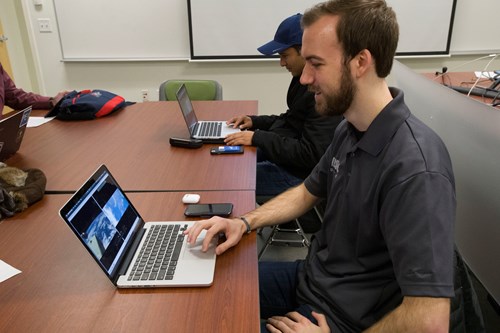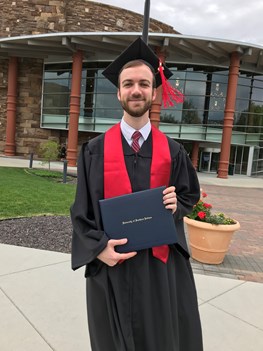by Darla Perigo
Zackrey Snyder ’19, computer science, is one of several USI students who built and launched the University’s UNITE CubeSat satellite that has now been in orbit more than 100 of the 400 plus days it is designed for. This is a critical benchmark, because many CubeSats fail within the first 60 days; some even fail at deployment.
The importance of reaching this milestone isn’t lost on Snyder, who, as the sole computer science major on the team, wrote most of the software programming. USI’s CubeSat, which is orbiting in a relatively unexplored area of space called the extremely low earth orbit (ELEO), has three main missions. First, a Langmuir plasma probe measures plasma and how the sun interacts with our atmosphere. Second, sensors onboard measure the CubeSat’s internal and external temperatures as it orbits the sun and tracks behind Earth. The data compares the hot and cold temperatures with a thermal model designed by one of the team members. Third, an onboard GPS tracks the orbital decay as the CubeSat gets closer to Earth and eventually burns up.
 Snyder worked with the other team members to not only understand each of these subsystems and how they interact with the others, but then designed the software to “do what it’s supposed to do. The software had to handle the plasma code and had to know when to grab temperature data and GPS data.”
Snyder worked with the other team members to not only understand each of these subsystems and how they interact with the others, but then designed the software to “do what it’s supposed to do. The software had to handle the plasma code and had to know when to grab temperature data and GPS data.”
Some courses blend computer science and engineering students, and it is how Snyder became part of the satellite project. An electrical engineering student, who had worked with him on class projects in digital logic, invited him to be part of the interdisciplinary team, which also included math and physics majors.
After attending a few meetings, he was intrigued with the idea. The programming was done in C language, which Snyder said is well suited for working in an embedded computer system. He was learning C in his microcomputers class, as well as from working with engineering students.
“Some electrical engineering classes use embedded computers, so I was working with those students to learn some of the low-level protocols because they were building the hardware as I was programming it. So, I had to make sure the software was ready for the hardware they were building for it.” The information is sent through the Global Star Network, a satellite cellular network, and returned as raw ones and zeros. It transmits in real time, soon after it samples. Snyder designed how the information is sent down and turned into meaningful data, like temperatures, and team members access and monitor it all through a dashboard.
 Snyder, who was the recipient of Romain College’s Outstanding Achievement Award in Computer Science in 2019, takes pride in USI being the first of the 23 university teams with the same NASA grant to get a CubeSat to space. It’s also the first spacecraft built and flown by a public institution in the state of Indiana. From those initial meetings filled with space jargon, his journey has been a fulfilling one. From early reading of research publications about CubeSats or working all night perfecting presentations and testing components, his path has now taken him to Wallops Flight Facility in Virginia, where he and his team presented to NASA officials, and to the Kennedy Space Station for VIP viewing of the launch of the Falcon 9 rocket that carried the CubeSat to the International Space Station on December 5, 2018. On January 31, 2019, the team gathered in the Business and Engineering Center control room for the breath-taking experience of watching the deployment of the USI CubeSat into space via a livestream from NASA.
Snyder, who was the recipient of Romain College’s Outstanding Achievement Award in Computer Science in 2019, takes pride in USI being the first of the 23 university teams with the same NASA grant to get a CubeSat to space. It’s also the first spacecraft built and flown by a public institution in the state of Indiana. From those initial meetings filled with space jargon, his journey has been a fulfilling one. From early reading of research publications about CubeSats or working all night perfecting presentations and testing components, his path has now taken him to Wallops Flight Facility in Virginia, where he and his team presented to NASA officials, and to the Kennedy Space Station for VIP viewing of the launch of the Falcon 9 rocket that carried the CubeSat to the International Space Station on December 5, 2018. On January 31, 2019, the team gathered in the Business and Engineering Center control room for the breath-taking experience of watching the deployment of the USI CubeSat into space via a livestream from NASA.
The team is currently in recruiting mode because Snyder and some of the other team members graduated in the spring. The CubeSat still has about another year in orbit, and he plans to stay involved to help the person who replaces him.
Snyder’s career has taken him to Crane Naval’s Global Defense Division conducting quality control testing of software. He “100%” encourages students to pursue computer science. “Computer science is not going anywhere any time soon. It’s actually becoming even more important to have some kind of programming skill in your work. I’ve known people who could move up in their company if they had programming skills, and they are finding it out now, after college. If students could at least get some kind of basic-level computer science classes under their belt, it would be very helpful. Employers are always looking for someone to write some code. As long as you can think through problems logically, that’s what programming is all about.”